红肉税和警示标签对随机对照试验所选食品类别的影响
IF 5.6
1区 医学
Q1 NUTRITION & DIETETICS
International Journal of Behavioral Nutrition and Physical Activity
Pub Date : 2024-04-15
DOI:10.1186/s12966-024-01584-9
引用次数: 0
摘要
大量食用红肉和加工肉类会对健康和环境造成危害。红肉警示标签和红肉税从总体上减少了消费者对红肉的选择,但人们对这些潜在政策如何影响购买与健康和环境结果相关的红肉子类(如加工与未加工)或非红肉食品(如奶酪、豆类)知之甚少。本研究通过随机对照试验考察了消费者对警告标签和红肉税的反应。2021 年 10 月,我们招募了 3518 名美国成年人,让他们在一家自然的网上杂货店完成一项购物任务。参与者被随机分配到四组中的一组:对照组(无警告标签或税收)、仅有警告标签组(健康和环境警告标签出现在含有红肉的产品旁边)、仅有税收组(含有红肉的产品价格提高 30%)或警告标签+税收组合组。参与者选择假设购买的商品,我们根据是否含有动物和植物来源成分(如牛肉、鸡蛋、豆类)、肉类加工程度(如加工猪肉与未加工猪肉)和肉类种类(如牛肉与猪肉)将其分为不同的食品组。我们评估了警示标签和税收对各食物类别选择的影响。与对照组相比,所有三种干预措施都使参与者减少了对加工肉类的选择(原因是加工猪肉的减少),并减少了对未加工肉类的选择(原因是未加工牛肉的减少)(仅对税收和警示标签+税收干预措施而言)。所有三种干预措施还导致参与者选择更多含有奶酪的食品,而只有警示标签+税收的综合干预措施导致参与者选择更多含有加工家禽的食品。除了征税干预措施增加了豆类的选择外,其他干预措施并未影响鱼类或海鲜(加工或未加工)、鸡蛋或植物性食品(豆类、坚果和种子、豆腐、仿肉、谷物和土豆、蔬菜)的选择。减少红肉消费的政策还可能影响与健康和环境结果相关的其他类型食品的消费。www.clinicaltrials.gov 上的 NCT04716010 。本文章由计算机程序翻译,如有差异,请以英文原文为准。
Effects of red meat taxes and warning labels on food groups selected in a randomized controlled trial
High consumption of red and processed meat contributes to both health and environmental harms. Warning labels and taxes for red meat reduce selection of red meat overall, but little is known about how these potential policies affect purchases of subcategories of red meat (e.g., processed versus unprocessed) or of non-red-meat foods (e.g., cheese, pulses) relevant to health and environmental outcomes. This study examined consumer responses to warning labels and taxes for red meat in a randomized controlled trial. In October 2021, we recruited 3,518 US adults to complete a shopping task in a naturalistic online grocery store. Participants were randomly assigned to one of four arms: control (no warning labels or tax), warning labels only (health and environmental warning labels appeared next to products containing red meat), tax only (prices of products containing red meat were increased 30%) or combined warning labels + tax. Participants selected items to hypothetically purchase, which we categorized into food groups based on the presence of animal- and plant-source ingredients (e.g., beef, eggs, pulses), meat processing level (e.g., processed pork versus unprocessed pork), and meat species (e.g., beef versus pork). We assessed the effects of the warning labels and tax on selections from each food group. Compared to control, all three interventions led participants to select fewer items with processed meat (driven by reductions in processed pork) and (for the tax and warning labels + tax interventions only) fewer items with unprocessed meat (driven by reductions in unprocessed beef). All three interventions also led participants to select more items containing cheese, while only the combined warning labels + tax intervention led participants to select more items containing processed poultry. Except for an increase in selection of pulses in the tax arm, the interventions did not affect selections of fish or seafood (processed or unprocessed), eggs, or plant-based items (pulses, nuts & seeds, tofu, meat mimics, grains & potatoes, vegetables). Policies to reduce red meat consumption are also likely to affect consumption of other types of foods that are relevant to both health and environmental outcomes. NCT04716010 on www.clinicaltrials.gov .
求助全文
通过发布文献求助,成功后即可免费获取论文全文。
去求助
来源期刊
CiteScore
13.80
自引率
3.40%
发文量
138
审稿时长
4-8 weeks
期刊介绍:
International Journal of Behavioral Nutrition and Physical Activity (IJBNPA) is an open access, peer-reviewed journal offering high quality articles, rapid publication and wide diffusion in the public domain.
IJBNPA is devoted to furthering the understanding of the behavioral aspects of diet and physical activity and is unique in its inclusion of multiple levels of analysis, including populations, groups and individuals and its inclusion of epidemiology, and behavioral, theoretical and measurement research areas.

 求助内容:
求助内容: 应助结果提醒方式:
应助结果提醒方式:


